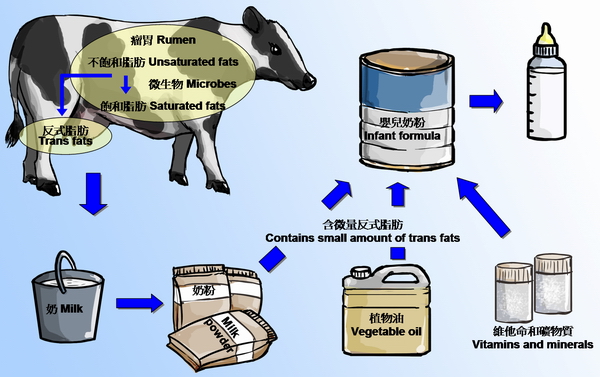
Food Safety Focus (85th Issue, August 2013) – Incident in Focus
Trans Fats in Infant Formula – Avoid the Unavoidable?
Reported by Dr. Violette LIN, Scientific Officer,
Risk Assessment Section,
Centre for Food Safety
In early July 2013, a newspaper reported that some infant formulae in the Mainland contained trans fats at 0.4-0.6g/100g powder that could lead to heart disease and should be avoided by infants. The China Food and Drug Administration subsequently issued a statement noting that the levels of trans fats in over 10 000 samples of Mainland-produced (0.019-0.574g/100g) and imported (0.024-0.367g/100g) formulae for infants and young children were within national and international safety standards.
What are Trans Fats and Where Do They Come From?
Trans fats are unsaturated fats with at least a double bond in trans configuration. Trans fats can come from natural sources or be formed during food processing.
Natural trans fats occur at low levels in milk and milk products (e.g. cheese, butter), meat of ruminants (e.g. cattle, sheep, goats), and in human breastmilk. In ruminants, small amount of trans fats may be formed when microbes in the animal's stomach convert unsaturated fats to saturated fats. Depending on the breed, the feed and the season, dairy and beef fat typically contain trans fats at 3-6% of total fat.
Trans fats may be formed during the hydrogenation process of vegetable oils for producing the semi-solid and solid fats that are widely used in food manufacture and catering outlets (e.g. margarines, biscuits, pastries). These partially hydrogenated oils, which are relatively inexpensive, can increase the shelf life and enhance the texture of the food. Low levels of trans fats may be generated when refining vegetable oils at high temperatures.
Why Do Trans Fats Appear in Infant Formulae?
The trans fats detected in infant formulae are likely from milk fat and vegetables oils (see Illustration). Since trans fats are endogenous components of milk fat, the Codex Alimentarius Commission (Codex) allows the use of milk fat in infant formulae and accepts up to 3% of total fatty acids from trans fats. However, according to Codex standard, commercially hydrogenated oils and fats shall not be used in infant formulae.

Sources of trans fats in infant formula
How Does Excessive Trans Fats Intake Affect Health?
Excessive trans fats intake increases the risk for coronary heart diseases (CHD) through raising low-density lipoprotein cholesterol and decreasing high-density lipoprotein cholesterol in the blood. The Food and Agriculture Organization of the United Nations suggests children aged 2-18 years and adults to have less than 1% of daily energy intake from trans fats from ruminant and industrially-produced sources. This is because there is convincing evidence that trans fats from commercial partially hydrogenated vegetable oils increase risk of CHD. However, currently there is no evidence that trans fats intake has a safety issue in normal infants 0-24 months old.
Trans fats are not synthesised by the human body and are not required in the diet. Whilst natural trans fats cannot be removed entirely from the diet, their intake is low in most populations worldwide and to date there is no conclusive evidence supporting an association between CHD risks and the amount of natural trans fats usually consumed. In contrast, trans fats formed during food processing have no health benefits but clear risks to health.
How to Avoid Trans Fats in the Diet?
The World Health Organization (WHO) recommends that energy intake from total fat should be limited, and fat consumption should be shifted away from saturated fat to unsaturated fat and towards the elimination of trans fats. The Centre for Food Safety has been studying the trans fats content in various foods. The Nutrition Information Inquiry System or the information in the nutrition labels can help consumers to choose foods with no or lower trans fats.
Even though natural trans fats are present in small amounts in both infant formulae and breastmilk, WHO advocates breastmilk as the ideal natural food for the healthy growth and development of infants. The Department of Health encourages parents to exclusively breastfeed infants for the first six months of life and then provides complementary foods while breastfeeding continues for up to two years of age or beyond.
Key Points to Note:
- Low levels of trans fats can be present in infant formulae from milk fat and vegetable oils.
- It is normal to find small amount of trans fats in infant formulae.
- Currently, there is no evidence showing that trans fats in infant formulae could lead to heart disease in infants.
Advice to the Consumers
- Breastmilk is the ideal food for the healthy growth and development of infants.
- When it is necessary to choose infant formulae, purchase them from reliable sources.
Advice to the Trade
- Apply good manufacturing practice when producing infant formulae.
- Obtain infant formula supplies from reliable sources which comply with Codex requirement for trans fats content.


